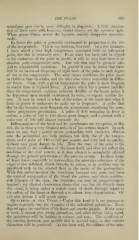Page 655 - My FlipBook
P. 655
THE PULSE. 665
sometimes give rise to some difficulty in diagnosis. A little observa-
tion of these cases will, however, almost always set the operator right.
When grave illness occurs the hysteria usually disappears spontane-
ously.
In fevers the pulse is generally accelerated in proportion to the rise
of the temperature. This is not uniform, however. In a few instances
I have noted a very high temperature associated with an infrequent
pulse, but this is evidently rare. From what has been said in regard
to the variations of the pulse in health, it will be seen that there is no
absolute pulse-temperature ratio. Any rule that may be given is sub-
ject to considerable variations. In general it may be stated that there
will be an increased frequency of eight beats of the pulse to each degree
of rise in the temperature. The same causes accelerate the pulse more
in children than in adults, and the ratio also varies somewhat in differ-
ent fevers. Thus, with a given temperature the pulse is more frequent
in scarlet than in typhoid fever. A pulse which has a greater rapidity
than the temperature explains indicates debility of the heart, unless it
be dependent upon mental excitement, hysteria, or organic cardiac dis-
ease. It may be stated as a law of the action of the heart that what it
lacks in power it endeavors to make up in frequency. A jjulse that
day by day becomes more frequent, the temperature remaining the same,
shows progressive prostration. A pulse of 130 occurring in fever is
serious, a pulse of 140 to 150 shows great danger, and a patient with a
pulse-rate of 160 will almost certainly die.
Inflammations of the heart and its membranes are exceptions to this
rule, for in these a very frequent pulse is of less serious import. In such
cases we may find a pretty severe pericarditis with extensive eifusion
into the pericardial sac, with perhaps but little rise of the temper-
ature, and a pulse of 140 to 150 per minute, and very bad in quality,,
without very great danger to life. Here the state of the pulse is the
direct result of the condition of the heart itself, and does not reflect the
condition of the vital powers, as it does when it is secondarih^ aifected
through the general prostration of the nervous system. In these forms
of heart lesion, especially in endocarditis, the muscular substance of the
organ is also inflamed, which disturbs its action, or its motions may be
interfered with by the exuded fluid in the cavity of the pericardium.
With this embarrassment the circulation becomes very poor, and from
the want of oxygenation of the blood the patient may show consider-
able blueness of the skin ; the breathing too may be proportionately
hurried ; yet clinical observation shows that very few die directly from
this cause, it being rather a remote cause of death through injury to
the valves of the heart or through a resultant fatty degeneration.. Of
valvular lesions I will speak again.
Qualities of the Pulse.—Under this head it is my purpose' to
inquire especially into the character of the individual pulsations. These
depend upon the condition of the heart and arteries jointly. If the heart
is weak, it cannot give strong pulsations, and, other things being equal,
the pulsations will be lacking in volume and tone. The condition of
the arteries, however, may modify this in several ways, so that various
characters will be produced. As has been said, the calibres of the arte-


